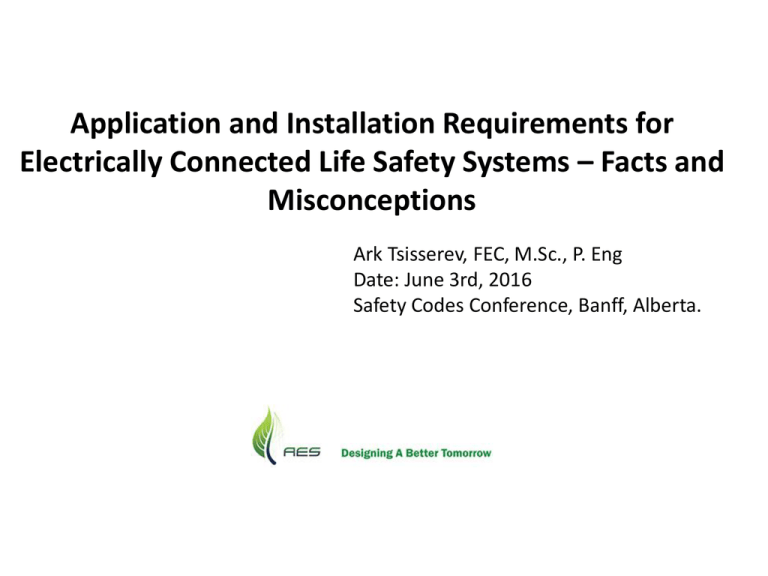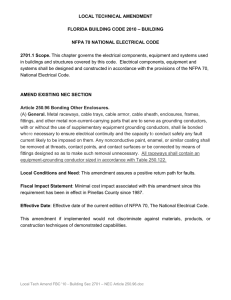Application and Installation Requirements for Electrically Connected
advertisement

Application and Installation Requirements for Electrically Connected Life Safety Systems – Facts and Misconceptions Ark Tsisserev, FEC, M.Sc., P. Eng Date: June 3rd, 2016 Safety Codes Conference, Banff, Alberta. Brief Summary “This seminar covers provisions of the CE code, Building Code, relevant CSA, NFPA and ULC standards for application and installation electrically connected life and fire safety equipment such as fire alarm systems, emergency generators, fire pumps, sprinkler systems including heat tracing equipment, transfer switches, smoke alarms, exit signs, emergency lighting, electromagnetic locks, hold open devices, elevators and protection of conductors supplying this equipment against exposure to fire.” What? Why? How? What? 1. Criteria for application, installation, interconnection and performance of electrical equipment that is specifically mandated by the NBCC to function as life and fire safety equipment What Fire protection requirements of the NBCC ARE ALREADY IN THE CE CODE: WHAT? (CONT’D) A) installation of conductors and raceways (i.e. use of thermal insulation, fire spread, flame spread, protection of conductors against exposure to fire, etc), and WHAT? (CONT”D) B) Construction of electrical equipment rooms and electrical equipment vaults Why? To assist electrical designers, installers and regulators in a consistent application of the CE code requirements and the CE code references on this subject. Why? (Cont’d) 1.Design of such electrical equipment as fire alarm systems, emergency generators, fire pumps, heat tracing of sprinkler systems, smoke alarms, emergency lighting, electrically connected exit signs, hold open devices, electromagnetic locks, smoke control and smoke venting equipment is done by the electrical consultants, and it is indicated on electrical plans and specifications. Why? (Cont’d) This design also includes provision for fire stops around conductors and raceways, selection of FT rating for conductors and methods of conductor protection against exposure to fire. Why? (Cont’d) 2. Installation of such electrical equipment is done by electrical contractors in accordance with the design accepted by the AHJ. Installation of such electrical equipment must be done in conformance with the CE Code and with applicable installation standards such as: WHY? (CONT’D) ULC S524 (fire alarm systems) CSA C282 (emergency generators) NFPA 20 (fire pumps) NFPA 13 (flow switches of a sprinkler system) NBCC (all of the above equipment) Why? (Cont’d) This means that in addition to knowing the CE Code requirements, electrical contractors must clearly understand provisions of specific codes and standards that govern installation of life and fire safety equipment Why? (Cont’d) 3. Acceptance of such design and installation is not always consistent, as different AHJ’s may administer requirements for application, installation and operation of life safety systems, requirements for fire stops around conductors and raceways and requirements for protection of conductors supplying life safety systems against exposure to fire. How? 1. By applying Rule 2-128 of the CE Code (2015 edition) regarding fire stops around conductors and raceways that penetrate fire rated assemblies. 2. By applying Rules 2-130 and 2-132 of the CE Code regarding flame spread requirements for conductors with combustible jackets and for combustible raceways. How? (Cont’d) 3. by applying Rules 26-012 and 26-350 of the CE Code regarding construction of electrical equipment rooms and electrical equipment vaults. 4. By applying Rule 32-200 of the CE Code regarding protection of a fire pump conductors against exposure to fire. How? (Cont’d) 5. By using cross-references between the CE Code rules and the NBCC provisions (see a few examples of Appendix G below) How? (Cont’d) Appendix G – Electrical installations of fire protection systems Note: This appendix is an informative (non- mandatory) part of this standard. How? (Cont’d) G1. Introduction G1.1 This Appendix lists requirements related to electrical installations that are not governed by Rules of the Canadian Electrical Code, Part I, but are required by the National Building Code of Canada. How? (Cont’d) G1.2 References listed in this Appendix are associated with electrical installations that are a part of the fire protection requirements contained in the National Building Code of Canada. How? (Cont’d) G2.3 Provincial and municipal building codes may alter the National Building Code of Canada, and users of this list should also check those codes. G3. Canadian Electrical Code reference to the National Building Code of Canada – 2010 Edition CEC Sections NBCC Sections, wand Rules sentences (unless otherwise stated, references refer to Division B of the of the NBCC) How? (Cont’d) Section O Article 1.4.1.2 of Division A of the NBCC Definitions of words and phrases Article1.5.1.1 of Division A of the NBCC Application of the referenced documents. Code over referenced documents How? (Cont’d) Table 1.3.1.2, Effective date and edition of referenced documents (e.g., NFPA 96, NFPA 20, NFPA 13, CAN/ULC-S524, etc.) How? (Cont’d) Rule 2-122 of the CE Code – Article 3.8.5.7. of the Building Code, Mounting height of electrical controls in barrier-free areas How? (Cont’d) Rule 2-124 - 3.1.9.1.(1) and (2), Fire stopping of service penetrations through fire-rated assemblies or fire separations How? (Cont’d) Rule 2-124 - 3.1.9.3., Penetration of fire-rated assemblies or fire separations by wires, cables, boxes, and raceways. How? (Cont’d) 6. By using specific checklists or other forms that capture requirements for installation of life safety systems. (See AES checklist below) Components of a Typical Fire Alarm System Fire alarm initiating devices (input) Control and processing equipment (interface) Signal devices (output) smoke detector CPU audible signal device heat detector manual station visual signage device Annunciator voice communication device water flow device ancillary devices: CACF elevator homing door; door hold open devices; electromagnetic locks; smoke control equipment, smoke venting equipment) signal to fire department Note: All fire alarm components that are mandated to be electrically supervised (electrical supervision of wiring) are subjected to verification. Electrical Supervision Required by ULC S524 General: • • • • • • • • • • • • • Electrical supervision of the wiring shall be provided to the following: Manual Stations; Fire Detectors; Water flow devices for water based fire protection systems; National Building Code of Canada required supervisory devices for water based fire protection systems; Audible signal devices; Visible signal devices; Voice communication equipment; Emergency telephone handsets; Primary power supplies and emergency power supplies; Power supplied to field devices; Annunciators; Display and control centre at the central alarm and control facility; and Common fault indication from the engine driven generator, as required by Clause 3.2.4.2. Electrical Supervision of fire alarm systems devices



